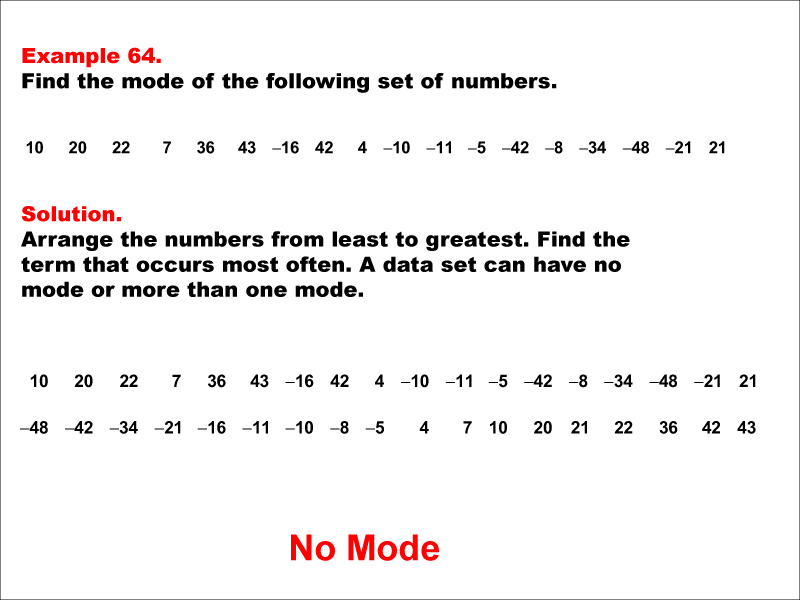
Display Title
Math Example--Measures of Central Tendency--Mode: Example 64
Display Title
Math Example--Measures of Central Tendency--Mode: Example 64

Topic
Measures of Central Tendency
Description
This example showcases a situation of measures of central tendency, where the goal is to identify a key summary measure in a set of data. The image shows Example 64 with a list of numbers. After sorting them in ascending order without any repetition in frequency higher than others, it concludes with "No Mode." This example reinforces the concept that not all data sets have a mode, particularly when each number in the set appears only once.
Measures of Central Tendency lessons are instrumental in providing students with a better understanding of how to interpret data through these examples. Each example highlights distinct scenarios which reinforce the concept of determining frequency of occurrences within given sets, enhancing students' analytical skills.
Seeing multiple worked-out examples is crucial in solidifying a student's grasp on a concept. Each example contributes unique perspectives and challenges that can arise when thinking about data sets. This varied approach not only caters to diverse learning styles but also ensures that all students can see the relevance of these concepts in their learning journey.
Teacher's Script
Let's examine this intriguing example. We have the following set of numbers: 10, 20, 22, 7, 36, -43, 16, 42, 4, 10, 11, 5, -42, -8, -34, -48, -21, and 21. Our task is to find the mode. Remember, the mode is the value that appears most frequently in a data set. Let's start by arranging these numbers from least to greatest. Now, look carefully at our sorted list. Do you notice any numbers that appear more than once? That's right, each number appears only once. What does this mean for our mode? Exactly, we have no mode in this data set. This is an important lesson because it shows us that not every data set will have a mode. In real-world data, this could indicate a wide variety of values with no clear 'most common' value. For instance, if these numbers represented the temperatures recorded over a period, it might suggest a highly variable climate with no dominant temperature range.
For a complete collection of math examples related to Measures of Central Tendency click on this link: Math Examples: Measures of Central Tendency: Mode Collection.
| Common Core Standards | CCSS.MATH.CONTENT.6.SP.B.4, CCSS.MATH.CONTENT.6.SP.A.3, CCSS.MATH.CONTENT.HSS.ID.A.2, CCSS.MATH.CONTENT.HSS.ID.A.3 |
|---|---|
| Grade Range | 6 - 12 |
| Curriculum Nodes |
Algebra • Probability and Data Analysis • Data Analysis |
| Copyright Year | 2014 |
| Keywords | data analysis, tutorials, measures of central tendency, mode, average |